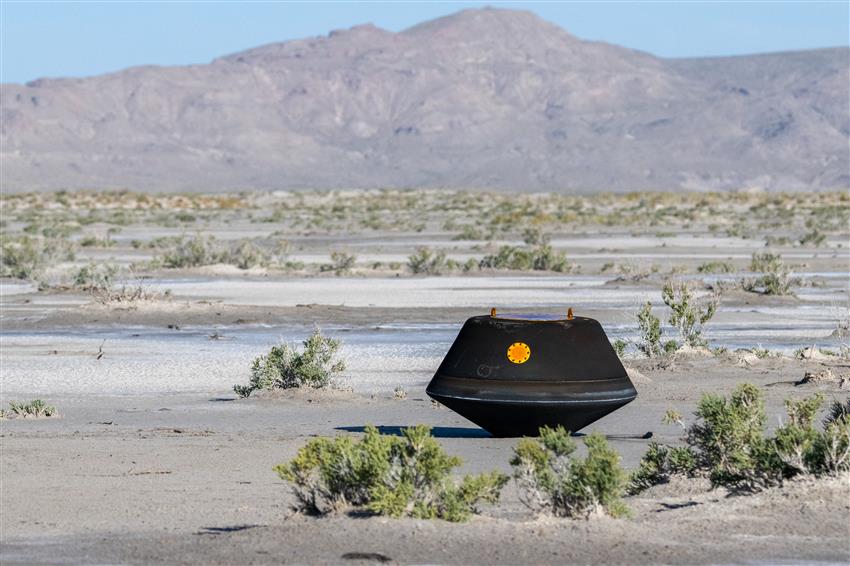
A spacecraft that left Earth more than seven years ago brought back a sample of dust and rocks from a distant asteroid in September. Scientists think the sample may help them understand more about our solar system, and even how life began on Earth.
The mission was called OSIRIS-REx, which stands for Origins, Spectral Interpretation, Resource Identification and Security – Regolith Explorer.
The OSIRIS-REx craft was launched by NASA in 2016. Its mission was to travel to a 4.5-billion-year-old asteroid known as Bennu and retrieve a sample from it for scientists to study back on Earth. (See TKN’s 2016 article: Space Probe Will Fetch Asteroid Sample)
The spacecraft touched down on Bennu in October 2020, scooped up a sample of dust and rocks and stored it in a sealed container inside a special capsule. Then it began its journey back to Earth, travelling more than six billion kilometres altogether.
On September 24, 2023 when the spacecraft was about 100,000 kilometres away from Earth, it released the capsule containing the sample. Once the capsule entered Earth’s atmosphere, it used a series of parachutes to slow itself down until it landed safely in a stretch of desert in Utah, in the southwestern United States.
Scientists from NASA were waiting to retrieve the capsule. They had to be very careful when they handled it to make sure no dirt or debris from Earth got mixed in with the asteroid sample. They took the capsule to a special “clean room” at the Johnson Space Center in Houston, Texas so they could open it safely.
When they opened the capsule, they were surprised to discover that extra material from the asteroid had been collected by accident. In addition to the sample inside the sealed container, there was another 1.5 grams of dark powder and sand-sized particles that had been caught between the top of the container and the lid of the capsule that carried it. In total, about 250 grams of material from Bennu were brought to Earth.
Most of the material will remain at the Johnson Space Center to be studied, but smaller samples will be sent to scientists and labs around the world, including the Canadian Space Agency (CSA).
(CSA provided a special laser instrument for the mission, called OLA or OSIRIS-REx Laser Altimeter. OLA made it possible to create a 3D map of Bennu’s surface so scientists could decide where the spacecraft should land to collect the sample.)
NASA scientists have already begun studying the bonus material, using different methods like X-rays, chemical analysis, infrared measurements, and an electron microscope. They found that the material contains both carbon and water—two substances that are considered to be essential for life on Earth. Scientists believe that asteroids like Bennu may have crashed into Earth billions of years ago, and the water and carbon they contained made life possible.
Scientists think the sample from Bennu will help them learn more about how our planet and our solar system developed. They also hope that the mission will help us understand the movements of asteroids that could potentially collide with Earth some day.
The OSIRIS-REx spacecraft did not return to Earth. Now that it has delivered the sample from Bennu, it will head toward another asteroid, called Apophis. The spacecraft will enter into orbit around Apophis in April 2029 and study it closely for 18 months, although it won’t be able to take a sample. The mission has now been renamed OSIRIS-APEX, short for Origins, Spectral Interpretation, Resource Identification and Security – Apophis Explorer.
Think & Discuss
The article notes that the sample from Bennu will help scientists learn about how our planet and solar system developed. What (and how) do you think they can learn from asteroid dust and rock?
What else do you know about NASA missions? How did you learn about them?
Links to more information
Global News video of landing with recap of mission (2:22 video): https://www.youtube.com/watch?v=Of8Ge34iY5o
NASA FAQs about OSIRIS-Rex: https://science.nasa.gov/mission/osiris-rex/osiris-rex-faq/
How CSA’s OSIRIS-Rex Laser Altimeter Helped Choose a Sample Site: https://www.asc-
csa.gc.ca/eng/satellites/osiris-rex/canadas-role.asp
Asteroid Activities from CSA: https://www.asc-csa.gc.ca/eng/satellites/osiris-rex/activities/







